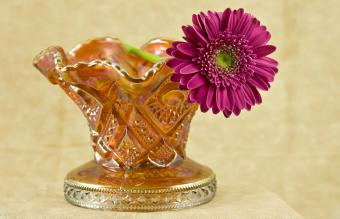
With its stunningly beautiful colors, iridescent glaze, and endless variety, carnival glass is a popular collector's item that used to be given away for free. Today, it's common for single pieces to fetch $30 to $50 at auction, with especially desirable items selling for much more.
Carnival Glass Prices at a Glance
This handy chart of example values can give you a glimpse at what some of the most valuable carnival glass can be worth.
| Carnival Glass Piece | Approximate Value |
|---|---|
| Northwood Grape and Cable punch bowl set | $2,000 |
| Dugan Farmyard 11-inch bowl | $3,800 |
| Northwood Greek Key plate | $1,700 |
| Fenton Blueberry water pitcher and glasses | $1,200 |
| Northwood Tree Trunk 12-inch vase | $1,000 |
Example Values for Carnival Glass

When you know that carnival glass was given away as prizes by carnival vendors (hence the name), it's easy to imagine that it might not be all that valuable. Turns out, that's not the case at all. Today, collectors will pay top dollar for prime examples while still assigning value to more common pieces, too.
- A punch bowl set in Northwood's Grape and Cable pattern in the coveted marigold color recently sold on eBay for about $2,000.
- A rare 11-inch bowl in Dugan's Farmyard pattern sold on eBay for more than $3,800. It was in perfect condition.
- A deep blue carnival glass plate in Northwood's Greek Key pattern sold for about $1,700. It was in perfect shape and had a rare ribbed back.
- A seven-piece set of a white carnival glass pitcher and six glasses in Fenton's Blueberry pattern sold for just under $1,200.
- Retailers like CarnivalGlass.com regularly sell pieces in the range of $35 to $85. These are smaller vases, bowls, plates, and some serving pieces.
Factors Affecting Antique Carnival Glass Value

Because there are so many patterns, colors, and types of carnival glass on the market, there are a number of factors that can affect the value of an individual piece. In general, the rarer the item and the better its condition, the more it will be worth. Consider the following as you examine a piece.
Type of Item
Manufacturers made everything from tiny figurines to huge serving sets out of carnival glass. But in general, the more useful an item is in today's world, the more value it has. Obviously, there are many exceptions when it comes to rare pieces, but things like vases, pitchers, bowls, and platters are highly valued. It's also handy to know that items in a complete set, such as drink or berry serving sets, are among the most valuable.
Size
Many factories created the same type of item in the same pattern in different sizes. If all other factors are equal, larger sizes tend to be more valuable. For instance, a six-inch Northwood Tree Trunk vase in amethyst sold recently on eBay for about $46. A 12-inch example in the same pattern and color sold for almost $1,000.
Age
Collectors Weekly reports manufacturers began creating iridescent glass in 1907, so the oldest pieces are from this era. The glass is still made today, but pieces dating from before 1940 are the most valuable.
Older glass can have imperfections like bubbles, especially when we're talking about carnival glass. You can also tell whether a piece is old by checking when the pattern was made.
Manufacturers and Patterns
When identifying carnival glass, it's a good idea to do as much research as you can. There were dozens of manufacturers, each with many glass patterns and forms. Rare carnival glass prices can be pretty high, so this is good info to have. Some of the following patterns are especially rare and desirable:
- Fenton Glass Strawberry Scroll - a sweeping pattern featuring raised strawberries
- Millersburg Blackberry Wreath - a ring-shaped pattern with leaves and berries
- Northwood Poppy Show - an elaborate pattern with flowers and a scalloped edge
- Dugan Farmyard - a simple pattern with detailed animal figures
Colors

Carnival glass came in dozens of colors, including white milk glass (aka vintage milk glass), deep blacks and purples, vivid reds, blues, greens, and even pastels. Each manufacturer tried to outdo the others with new and unique colors, so the variety is amazing. The following colors are among the rarest and most valuable:
- Fenton Ambergina - a deep orange-red tone
- Northwood Marigold - a warm-toned deep yellow
- Fenton Cherry Red - a dark, glowing red
- Northwood Black Amethyst - a very dark purple that appears almost black
- Northwood Ice Green - a cool pastel green
Condition
Condition affects value significantly, but it isn't a deal-breaker with highly desirable pieces. Still, for most items, condition is something you should consider. The following types of damage can negatively affect value:
- Chips
- Cracks
- Scratches
- Discoloration
- Etching
It might not seem like part of assessing condition, but look to see if there is anything missing. Missing pieces can detract from the value of a set.
Look It Over
Collecting carnival glass is so fun, and the right pieces can be a good investment (or a windfall if you choose to sell them). Take some time to look over items you're considering to make sure you're getting a good deal.






